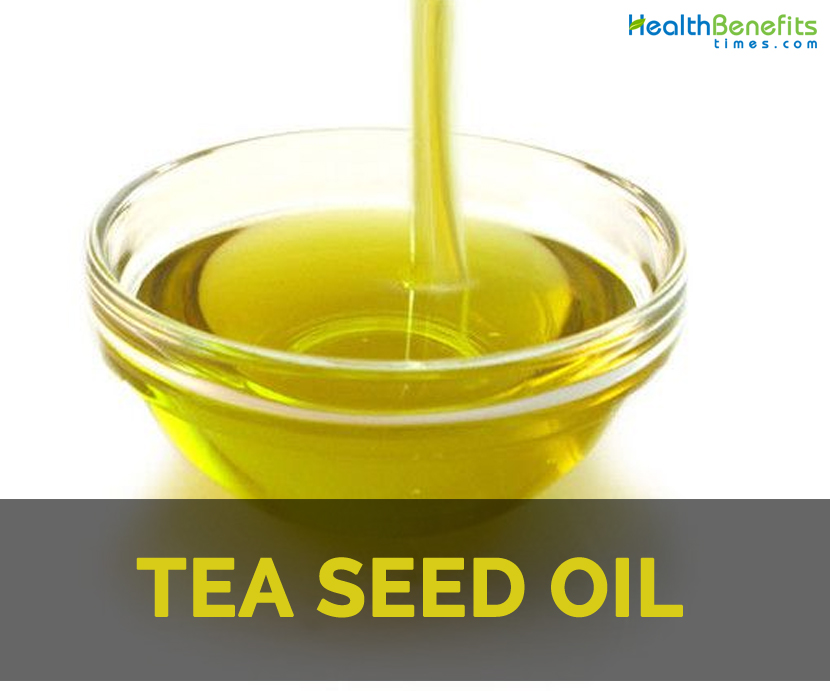History
This plant is extensively cultivated in China. It is found in thickets, forests, foothills, banks of streams at elevations of 500-1300 meters.
Nutritional value
In 218 g of Tea seed oil, it offers 1927 calories and 218 grams of total lipid fat. Along with this we could also get 45.998 g of total saturated fats, 0.218 g of lauric acid, 0.218 g of myristic acid, 38.15 g of palmitic acid, 6.758 g of stearic acid, 112.27 g of total monounsaturated fats, 1.09 g of palmitoleic acid, 108.782 g of oleic acid, 2.18 g of gadoleic acid, 50.14 g of total polyunsaturated fats, 48.396 g of linoleic acid, 1.526 g of linolenic acid and 222 mg of phytosterols.
Health Benefits of Tea seed oil
Tea seed oil which is also known as Camellia oil is the oil that is extracted from Camellia sinensis seeds. Due to its nutrient content, it is used in cooking as well as beauty products. It has light texture with light flavor. Let us discuss the health benefits provided by Tea seed oil below:
- Skin health
In China, tea seed oil is used by women for beauty purposes by adding it to homemade topical application products. It acts as a great moisturizer when applied to the skin due to thigh content of oleic acid. Its application after shower helps to lower paleness and dryness of skin. It also speeds up healing process of wounds, scrapes, cuts and acne scars. The anti-aging properties found in Tea seed oil helps to lower the sun damage.
- Hair health
Tea seed oil is used in the hair care products. Comb the hair with wooden comb which is dipped in Green tea oil. It makes easy to comb hair without tangles.
- Prevent cancer
Tea seed oil helps to prevent and lower the chances of uterus cancer, colon cancer and breast cancer.
- Strengthen immunity
The daily intake of Tea seed oil helps to enhance the functions of immunity by preventing the chances of infections and diseases. It is due to the presence of triterpenoids.
- Oxidative stress
Oxidative stress is responsible for degenerative diseases and heart diseases. An antioxidants found in Tea tree oil helps to counteract the damage made by free radicals.
http://oilhealthbenefits.com/camellia-oil-tea-seed-oil/
Traditional uses
- Tea tree oil is used to heal damaged and dry skin.
- It helps to reduce cholesterol and blood pressure level.
- It prevents the chances of cancers and cardiovascular ailments.
- In China, it is used for burning injuries and stomach ache.
- It lowers blood pressure, bad cholesterol, strengthen immune system and regulate nervous system.
- It helps to cure constipation.
Precautions
- It should not be confused with tea tree oil which is an essential oil extracted from paperbark leaves and is inedible.
- It should not be confused with Camellia oil which is extracted from the seeds of Camellia japonica.
- Allergic people should not use this oil.
How to Eat
- It is used for stir-frying vegetables and meat.
- It is used in sauces and salad dressings.
- It is used in marinades, dips and margarine.
Other Facts
- Tea seed oil is used in hair shampoo, soap, herbal candy and lotion.
- It resembles grape seed oil and olive oil.
- It is used to lubricate and cleanse some parts of machine.
- It is used in coating iron products which helps to prevent rusting.
- Tea seed oil is used to strengthen nails.
Tree seed oil facts
Tea seed oil is edible oil in pale amber to green having a sweet and herbal odor. Due to its high smoke point, it is suitable for stir-frying vegetables and meat. In Taiwan, it is used as cooking oil. It has high content of Vitamin E, antioxidants with no trans fats. It is an excellent source of minerals such as magnesium, phosphorus, iron, calcium and manganese. It is high in smoking point upto 485ºF with excellent storage qualities.
| Teaseed oil Quick Facts | |
|---|---|
| Name: | Teaseed oil |
| Scientific Name: | Camellia sinensis oil, Camellia oleifera oil |
| Origin | This plant is extensively cultivated in China. It is found in thickets, forests, foothills, banks of streams at elevations of 500-1300 meters. |
| Colors | Pale amber to green |
| Taste | Mild |
| Calories | 1927 Kcal./cup |
| Major nutrients | Total Fat (622.86%) |
| Health benefits | Skin health, Hair health, Prevent cancer, Strengthen immunity, Oxidative stress |
| Name | Teaseed oil |
|---|---|
| Scientific Name | Camellia sinensis oil, Camellia oleifera oil |
| Native | This plant is extensively cultivated in China. It is found in thickets, forests, foothills, banks of streams at elevations of 500-1300 meters. |
| Common/English Name | Camellia oil, Oil-seed Camellia, Tea Oil Camellia |
| Name in Other Languages | Japan: tsubaki; Taiwan: Kuu-Char; |
| Color | Pale amber to green |
| Odor | Sweet, herbal |
| Flavor/aroma | Subtle nutty |
| Taste | Mild |
| Major Nutritions | Total Fat (lipid) 218 g (622.86%) |
| Health Benefits |
|
| Calories in 1cup (218 gm) | 1927 Kcal. |
| Traditional uses |
|
| Precautions |
|
| How to Eat |
|
| Other Facts |
|
References:
https://www.academiapublishing.org/journals/ajmp/pdf/2013/April/Sahari%20and%20Amooi.pdf
http://www.waters.com/webassets/cms/library/docs/720002980en.pdf
http://www.onlyfoods.net/tea-seed-oil.html
https://en.wikipedia.org/wiki/Tea_seed_oil
file:///C:/Users/drchi_000/Downloads/36cc87b1-d32c-4110-b83a-d2d16b9e3917_about_tea_seed_oil.pdf
http://oilhealthbenefits.com/camellia-oil-tea-seed-oil/
http://www.onlyfoods.net/tea-seed-oil.html


